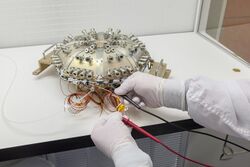Astronomy:ISIS (space probe instrument)
Integrated Science Investigation of the Sun, stylized IS☉IS, is an instrument aboard the Parker Solar Probe, a space probe designed to study the Sun.[1] ISOIS is focused on measuring energetic particles from the Sun, including electrons, protons, and ions.[2] The parent spacecraft was launched in early August 2018, and with multiple flybys of Venus will study the heliosphere of the Sun from less that 4 million kilometers or less than 9 solar radii.[3][4]
There is two major detectors part of IS☉IS, EPI-Lo and EPI-Hi corresponding to detection of relatively lower and higher energy particles.[5] EPI-Lo is designed to detect from about 20 keV per nucleon up to 15 MeV total energy, and for electrons from about 25 keV up to 1000 keV.[6] The detector for higher energies, EPI-Hi is designed to measure charged particles from about 1– to 200 MeV per nucleon and electrons from about 0.5 to 6 MeV, according to a paper about the device.[7]
The shortname includes the a symbol of the Sun, a circle with a dot in it.[8]
EPI-HI includes:[9]
- High Energy Telescope (1)
- HET has 16 detectors stacked
- Low Energy Telescopes (2)
- LET1 is double ended with 9 stacked detectors
- LET2 is single ended with 7 stacked detectors
The detectors are solid-state devices.[10]
EPI-Hi includes 8 wedge detectors, fed by 80 separate entrances.[11]
EPI-Lo can record differential energy spectra for:[12]
See also
- JEDI (instrument on Juno Jupiter orbiter that detects energetic particles at Jupiter)
- Solar symbol (about symbols for the Sun)
References
- ↑ JHUAPL. "Parker Solar Probe Instruments: IS☉IS" (in en). Parker Solar Probe. http://parkersolarprobe.jhuapl.edu/News-Center/Show-Article.php?articleID=86.
- ↑ [1]
- ↑ "NASA Solar Probe Flies By Venus on Its Way to 'Touch' the Sun". Space.com. https://www.space.com/42015-nasa-parker-solar-probe-first-venus-flyby.html.
- ↑ JHUAPL. "After Near-Perfect Trajectory Maneuver, Parker Solar Probe On Course To Touch The Sun" (in en). Parker Solar Probe. http://parkersolarprobe.jhuapl.edu/News-Center/Show-Article.php?articleID=96.
- ↑ McComas, D. J.; Alexander, N.; Angold, N.; Bale, S.; Beebe, C.; Birdwell, B.; Boyle, M.; Burgum, J. M. et al. (2014-07-05). "Integrated Science Investigation of the Sun (ISIS): Design of the Energetic Particle Investigation" (in en). Space Science Reviews 204 (1-4): 187–256. doi:10.1007/s11214-014-0059-1. ISSN 0038-6308. https://link.springer.com/article/10.1007/s11214-014-0059-1.
- ↑ McComas, D. J.; Alexander, N.; Angold, N.; Bale, S.; Beebe, C.; Birdwell, B.; Boyle, M.; Burgum, J. M. et al. (2014-07-05). "Integrated Science Investigation of the Sun (ISIS): Design of the Energetic Particle Investigation" (in en). Space Science Reviews 204 (1-4): 187–256. doi:10.1007/s11214-014-0059-1. ISSN 0038-6308. https://link.springer.com/article/10.1007/s11214-014-0059-1.
- ↑ McComas, D. J.; Alexander, N.; Angold, N.; Bale, S.; Beebe, C.; Birdwell, B.; Boyle, M.; Burgum, J. M. et al. (2014-07-05). "Integrated Science Investigation of the Sun (ISIS): Design of the Energetic Particle Investigation" (in en). Space Science Reviews 204 (1-4): 187–256. doi:10.1007/s11214-014-0059-1. ISSN 0038-6308. https://link.springer.com/article/10.1007/s11214-014-0059-1.
- ↑ JHUAPL. "Parker Solar Probe Instruments: IS☉IS" (in en). Parker Solar Probe. http://parkersolarprobe.jhuapl.edu/News-Center/Show-Article.php?articleID=86.
- ↑ [2]
- ↑ [3]
- ↑ https://ntrs.nasa.gov/archive/nasa/casi.ntrs.nasa.gov/20110013395.pdf]
- ↑ [4]


